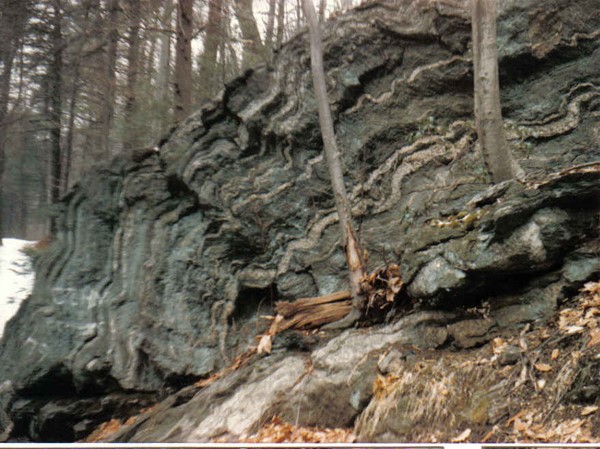While the pandemic has forced so many of us to retreat into the virtual world of Zoom calls and GoToMeetings, our counterbalance has been—correctly—to flood into green spaces like the Wissahickon and the Schuylkill Center. Parks everywhere have seen visitation rise as people turn to nature for its balm and healing. Still, it’s hard to socially distance in the Wissahickon, one of the most unusual and naturally beautiful places in the city.
And wildly unique geologically.
As spring begins to—sorry—spring and leaves finally pop out on trees, these are the last weeks to get great unobstructed views of the rocks that line the gorge. So read this column, then walk the Wissahickon with a new eye to the extraordinary forces that formed the landscape.
I talked last week with local geology expert Sarah West, one of our neighbors at Cathedral Village and a longtime Trail Ambassador with Friends of the Wissahickon. She developed—and has passed along to the next generation—geological walking tours, some of which are offered online on the FOW website.
As an earth science teacher, she went to a summer program for science teachers at Chestnut Hill College in 1985, where they took the group for a geology walk in the Wissahickon, “The trip was so fascinating,” she recalled, “but the teachers talked so fast and in such language that a few of us thought we should really translate this into language that people can understand. From that workshop I was inspired to start writing geology for the common folk.”
The result was a self-published book that came out in the early 90s featuring both the geology and the history of the Wissahickon valley. At about the same time, “Chestnut Hill College asked me to do geology walks for their students. We’d start at Valley Green and walk along the east side as far as the Rex Avenue bridge.” She began offering these walks for FOW, Mt. Airy Learning Tree, the Schuylkill Center and other groups, and Shawn Green, FOW’s Volunteer Manager, calls her walks “famous.”
“It’s a fascinating place,” she told me, “with close to the same number of rock types that you find out West like in the Grand Canyon.” Plus, she continued, “the Wissahickon is a backward stream. Think about it: most streams start in a mountain gorge and end in gently rolling land. The Wissahickon starts in gently rolling land and ends in a mountain gorge. The rock types change abruptly as you get to the gorge.” For Sarah, this is a clear signal that something is different.

Remember that the earth’s crust rests on plates that are slowly rearranging themselves. Wissahickon’s rock outcrops are “the roots of an ancient massive mountainous land,” more than 500 million years old. The rocks were laid down at the bottom of an ancient ocean, the Iapetus, who in mythology is the father of Atlantis. As the continents collided long ago, as Europe and Africa pushed against North America “at the rate your fingernails grow,” she noted, this ocean closed, and the collision raised the Appalachian Mountains, that chain found inland down the entire east coast.
As the ocean closed, the rocks in the Wissahickon “got adhered to the North American continent.” So they are rocks from somewhere else that got pushed here as plates rearranged themselves.
“Think of the Mediterranean Sea,” she explained, “which is a closing ocean. And whenever you have a closing ocean, you get a mountain range. Land masses like Italy and Sicily are stranded in this closing ocean; Italy is already stuck to Europe.” In fact, Italy’s collision is still pushing up the Alps; Sicily’s Etna is erupting even as I write.
One of the signature rocks in the valley is this schist, a metamorphic rock, loaded with mica flakes. “The schist started as clays formed in some kind of body of water, like a marshy area or delta, and became compacted. As plates moved, they got caught up in the collision, got heated up, pressured.” Because it was heated so slowly over so much time, many crystals have formed, not just mica, but garnets, which you can easily see in many schists in the valley. “My house in Mt. Airy had a big garnet in one rock, and lots of little ones.” In fact, much of the region’s houses (like my own) are built from mica schist.
Gneiss is another common Wissahickon rock, including a large one the FOW ambassadors have dubbed Sarah’s Rock, as it is her favorite. Gneiss is a family of rocks characterized by strong banding, and often those bands are twisted and turned, showing you the deformation forces deep underground as the rock was formed. “Sarah’s Rock probably descended from schist, and formed 10 miles down, and has worked its way to the surface slowly over the last 250,000 years,” as the rocks above it were slowly eroded down.
There’s so much more to write, and places for you to learn. On FOW’s website, check out Sarah’s “Gems of the Wissahickon” in the Creekside Classroom section—it gives the full picture. FOW’s Shawn Green notes that “Sarah often refers to herself as a ‘student of the Wissahickon,’ and she makes everyone she meets want to be the same.” Hope you will too.
—By Mike Weilbacher, Executive Director
